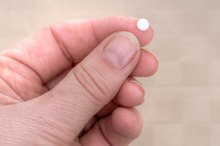Four Ways to Take Care of the Muscular System
The muscular system works with the bones to produce a wide range of movement but also plays an important role in breathing, digestion and the circulatory system. Preserve the function of the muscular system system by developing habits that reduce muscle stress and improve muscle function and strength.
Resistance Training
Resistance training increases muscle size by building thicker protein filaments, creating more fluid in the muscle cells and creating more myofibrils, which contain the protein filaments of the muscles. This type of training also increases strength, but the results vary widely from one person to the next. Dr. Len Kravitz of the University of New Mexico reports that resistance training increases the diameter of muscles by 20 to 45 percent. Resistance training also strengthens the heart muscle by increasing the thickness of the left ventricular wall and septum wall.
- Resistance training increases muscle size by building thicker protein filaments, creating more fluid in the muscle cells and creating more myofibrils, which contain the protein filaments of the muscles.
- Resistance training also strengthens the heart muscle by increasing the thickness of the left ventricular wall and septum wall.
Aerobic Exercise
How Can Exercise Improve Your Muscular System?
Learn More
Aerobic exercise has several beneficial effects on the muscular system. It strengthens the heart, increases endurance, improves muscle strength, increases muscle tone and helps to reduce body fat. Examples of aerobic exercise include jogging, walking, swimming and playing tennis. All of these activities increase the heart rate. The American Heart Association recommends at least 150 minutes of moderate exercise or 75 minutes of vigorous exercise per week.
- Aerobic exercise has several beneficial effects on the muscular system.
- Examples of aerobic exercise include jogging, walking, swimming and playing tennis.
Correct posture
Posture has a significant effect on the efficiency of the muscles and the amount of force required to carry out tasks. Poor posture also makes it difficult for the muscles and bones to work together to produce movement. Practice good posture to prevent these negative effects on the muscular system. When using a chair, sit up straight and put your shoulders back. Use a back support while driving to support your back and alleviate muscle tension. When standing upright or walking, don't slump, stand up straight and keep your shoulders back.
- Posture has a significant effect on the efficiency of the muscles and the amount of force required to carry out tasks.
- Use a back support while driving to support your back and alleviate muscle tension.
Maintain Normal Weight
How to Build Muscle Without Creatine
Learn More
Extra weight puts stress on the muscles and forces them to work harder. Maintaining a normal weight reduces this stress and prevents muscle aches and strains. Eat a diet low in saturated fat and cholesterol to reduce the number of calories you consume each day. Use aerobic exercise to burn calories and strengthen the heart. Perform strength training exercises to increase your muscle mass, because increased muscle mass improves your metabolism.
- Extra weight puts stress on the muscles and forces them to work harder.
- Perform strength training exercises to increase your muscle mass, because increased muscle mass improves your metabolism.
Related Articles
References
- Dr. Len Kravitz: Resistance Training: Adaptations and Health Implications
- American Heart Association: American Heart Association Recommendations for Physical Activity in Adults
- Iowa State University: Awkward Postures
- Cleveland Clinic: Posture for a Healthy Back
- Sutter Medical Center of Santa Rosa: Exercise Your Heart Muscle
- American Council on Exercise. How to select the right intensity and repetitions for your clients. Updated June 26, 2014.
- Wilson JM, Loenneke JP, Jo E, Wilson GJ, Zourdos MC, Kim J-S. The effects of endurance, strength, and power training on muscle fiber type shifting. J Strength Cond Res. 2012;26(6):1724-1729. doi:10.1519/JSC.0b013e318234eb6f
- Kraemer WJ, Ratamess NA, Fry AC, French DN. Strength testing: Development and evaluation of methodology. In: Maud PJ, Foster CF, editors. Physiological Assessment of Human Fitness. 2nd ed. Human Kinetics, 2006.
- DeFreitas JM, Beck TW, Stock MS, Dillon MA, Kasishke II PR. An examination of the time course of training-induced skeletal muscle hypertrophy. Eur J Appl Physiol. 2011;111(11):2785-2790. doi:10.1007/s00421-011-1905-4
- Farinatti P, Castinheiras Neto AG, da Silva NL. Influence of resistance training variables on excess postexercise oxygen consumption: A systematic review. Int Sch Res Notices. 2012;2013. doi:10.1155/2013/825026
- Ihalainen JK, Inglis A, Mäkinen T, et al. Strength training improves metabolic health markers in older individual regardless of training frequency. Front Physiol. 2019;10:32. doi:10.3389/fphys.2019.00032
- Piercy KL, Troiano RP, Ballard RM, et al. The Physical Activity Guidelines for Americans. JAMA. 2018;320(19):2020-2028. doi:10.1001/jama.2018.14854
Writer Bio
Leigh Ann Morgan began working as a writer in 2004. She has extensive experience in the business field having served as the manager of a $34 million rental property portfolio. Morgan also appeared as a guest on an episode of National Public Radio's "Marketplace Money" in 2005.







